Portrait of Rose
ーYukie Yasuda-Former president
“The most beautiful part of rose . . . is its stem”

Sketch by Setsuko Migishi
On the day of Star Festival in July 7 in 2004, I saw photographs of Hanae Mori at the time of her last show in Paris, and I reaffirmed the beauty of rose stem.
When the designer responded to the standing ovation of the crowds, in her hand was a long-stemmed yellow rose. I was so moved with her vision lifting a single stem of rose high reflecting her entire life and work. That’s right.
It is a spirit, in human terms, and heart. It is a straight stem that points out distinctly the heaven and shows the rose as a queen of flowers.
There are other flowers, than roses, that are expensive and merely beautiful. Honor, supremacy, superficial beauty – these are not enough to be complete by themselves and could not satisfy people.
A straight stem is a must-belonging to rose. It brings rose its dignity. That is why I consider rose as an enchanted flower..
Why is the gallery named “rose”? Why does rose have thorns?
The beauty of woman, Catherine Deneuve
While I appreciate young Catherine Deneuve in Belle de Jour, her beauty in Place Vendôme is somehow challenging.
I am overwhelmed by her overflowing human dignity. It resembles thorns of rose, saying “Don’t touch me.” .
Those thorns create a position of “rose”. A long straight stem with thorns dignifies rose. It is beautiful. Catherine Deneuve cannot hide a fleshier back and thicker arms, with the steady attack of old age. However, she is still beautiful.
For women, a battle against aging begins at the age of 50. With a dignified spirit of a rose, inner beauty, a unrefined natural, untouched, candid figure, Deneuve’s piercing, harsh gaze shows that her beauty is absolute. Even her wrinkles are beautiful. There is her strong determination to keep on living.
A owner of venerable and famous jewelry store on Place Vendôme had business troubles and committed suicide in his car. Catherine Deneuve plays his widow, Marianne. Before marrying 18 years ago, she loved a man. Despite her love for him, she was betrayed and deceived. As her husband died, she met the man after 20 years.
She asked him, “Can you fall in sleep right away at night?”
“No, I can’t sleep.”
“At sleepless nights, you should count the number,” she replied.
The world of paintings is same as that of this movie (Place Vendôme). Following the burst of economic bubble, the world changed and the scent of esprit seemed to disappear. The year 2003 marked the 100th Anniversary for Director Yasujiro Ozu. If he were alive now, how would he feel about the current Japanese culture?
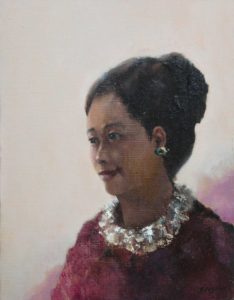
Wasaburo Itozono, Oil Painting (size 6)
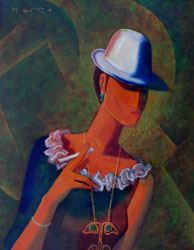
Matabee Goto, Oil Painting (size 10)
Why is the gallery named “rose”? Rose petals
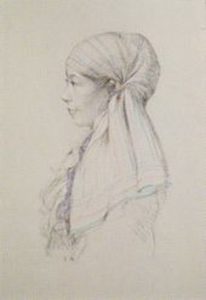
Sketch by Tadahiko Nakayama
Audrey Hepburn
Why do so many people recall rose when flowers are talked?
The petals of rose overlap each other to form the shape of rose flower. They gradually open from a bud, each creating independent beauty.
Having Audrey’s natural innocence, her uncontrived purity and her kind character, she is like an angel.
Why is the language of flower for rose “love and prosperity”?
Whatever the origin of this, even when a petal falls one by one, a beauty emerges one after another.
Like a rose, Audrey had a variety of beauty, being a star among stars. An angel sent to Earth by God. When a rose is cut away from the ground, it withers quickly. Audrey, too, unfortunately could not cope with fading beauty through years.
Her superiority could not be demonstrated. Perhaps God did not allow it.
Why is the gallery named “rose”? The scent of rose
Rose is imbued even with fragrance. Since the days of Cleopatra, it has been used as a perfume. There is rose wine as well.
Why were so many jewelries given to rose, such as beauty in the feature of flower, stem, and thorns. Rose blooms in all four seasons. Why did God grant rose such various decorations, even its fragrance?
In the West, lily is more valued. In the old sayings, look at the flower in the field rather than the glory of King Solomon. This flower was lily. Many painters have painted lily for a long time. Few painters have painted rose. To be certain, the purity of lily suits Maria well. Rose is too gorgeous for God, and is not appropriate for pious faith, but . . .
God gave rose the virtues of flowers. Many people love rose for their faint fragrance. Without that scent, what kind of flower would rose be? . . .
。

Kunio Makino, Oil Painting (size 10)
A painter who painted roses

Zenzaburo Kojima, “Rose,” Oil Painting (size 12)
Zenzaburo Kojima
From a long time ago, many artists have painted rose. Why is it so?
I didn’t know the answer when I became an art dealer. Over time, I learned that works depicting roses are well received by customers.
My favorite work with roses is the one by Zenzaburo Kojima. Having said that, I do not mean that I like any work for roses. Ryuzaburo Umehara’s rose paintings are popular and the flowers are wonderful, but they lack fragrance. Many of Kazumasa Nakagawa’s works have roses. They are more like self-portraits than paintings of roses. Why did Kazumasa keep on painting so many roses? . . . Preconception toward roses differs among painters.
There are painters who do not want to paint roses because they are too beautiful. With varieties and characters of rose flowers, the dignity of stems, mixture of fragrance, combination with vases and tablecloths, etc., I like the playful roses in the works of Zenzaburo Kojima. They are wonderful.
Works inspired by roses
Masuo Ikeda
One work inspired by roses is Masuo Ikeda’s “A Rose Is A Rose.”
My first purchase of a Masuo Ikeda work was made at his first solo exhibition at gallery in Nihonbashi.
The relationship between a painter and an art dealer is an odd one. Liking the works does not necessarily mean a close encounter. As Masuo Ikeda lived in New York, I felt his presence was far-away. This was the time when I had not yet traveled overseas.
This work delighted me that the image of rose in this painting was exactly same as my image of rose. “Yes! This is my image of rose!” It made me smile.
I also like the title, “A Rose Is A Rose.” I feel that I understand why Masuo Ikeda rendered the character of “Rose” in the title using Japanese character, katakana. For him, the rose should be written in these characters, not Chinese characters. There are a number of roses depicted on the shoes. For me, these must be glass shoes. They were glass shoes packed with aspiration. He did not title it so as to show its modern and stylish thought.
I deeply appreciated Masuo Ikeda through this work.
Seiichi Hara
Why did the artist give it this title? What did he want to express? . . . Impression is an intuitive one. Each person feels differently. It is actually enjoyable to square off against a work and imagine things, entirely separate from the commentaries on the work. After that, when I read the words of commentators and the artist, I find myself understandable to their words.
There may be many ways to approach appreciation, but I think it is best to first face a work through your own sensitivity. Read the work just like literature, then slowly enjoy feeling your emotion, and finally read the commentary. Literature shines once more when you read it and feel it in a totally new way. The enjoyment deepens. I think the enjoyment of paintings is exactly same as that of literature.
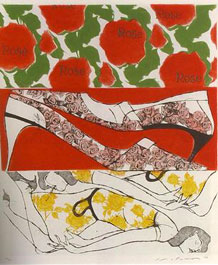
Masuo Ikeda
“A Rose Is A Rose.”
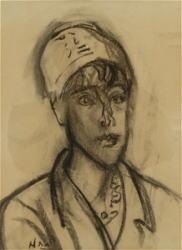
Sketch by
Seiichi Hara

